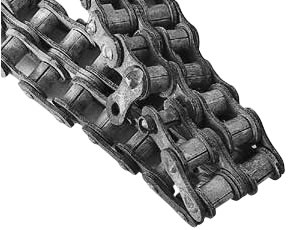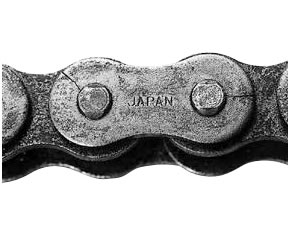Technical Data Handling Chains
8. Cautions on Use in Special Environments
As a general rule, chain should be used in a clean air flow; however, when used in special atmospheres, refer to the various items that follow.
8.1 Use in wet conditions
If the chain is used in a sterilizing machine or water screen, for example, where the chain is splashed with water or goes through heated vapor, the following problems may occur.
- 1. An increase in wear elongation due to improper or insufficient lubrication.
- 2. Decrease in fatigue strength from rust and corrosion (pitting) of the chain.
Action
- ・Reduce bearing pressure by using a larger sized chain to improve wear resistance.
- ・Use corrosion resistant chain for rust prevention.
8.2 Use in acidic or alkaline conditions
If chain is exposed to acidic or alkaline conditions, such as battery acid and liquid used in plating processes, the following problems may occur.
- 1. Embrittlement fracture of link plates and pins.
- 2. Fatigue breakage of link plates and pins due to rust and pitting corrosion.
- 3. Wear from usual mechanical wear and corrosion.
- 4. Reduction in volume of the whole chain from corrosion.
- 5. In special cases where the chain is underwater (immersed in liquid), electrochemical corrosion may occur.
- 6. There are also circumstances where even stainless steel roller chain will corrode.
Fig. 34 shows an example of chain that was used in a plating apparatus. The chain fell to pieces within one month due to the effects of the acid.
Countermeasures for embrittlement fractures (stress corrosion cracking)
- ・Adopt a brittleness countermeasure that lowers crack susceptibility.
- ・Install a cover or casing to prevent acids or alkalis from contacting the chain.
- ・Adopt a high-grade material with anti-corrosive properties.
Corrosion protection
- ・Use surface-treated chain.
- ・Install a cover or casing to prevent acids or alkalis from contacting the chain.
- ・Adopt a high-grade material with anti-corrosive properties.
In general, embrittlement fractures (stress corrosion cracking) occur around link plate holes.
This is the area where the pin and bush are press-fitted to the link plate, and with the highest concentration of stress. Cracks are generated even when there is no tension on the chain.
Chain in general is more susceptible to acids than alkalis, and in special cases, embrittlement fractures (stress corrosion cracking) are generated by seawater or pit water.

Fig. 34. Corrosion of stainless steel chain

Fig. 35. Hydrogen embrittlement cracking
8.3 Use under conditions where wear is a problem
If the chain is exposed to highly abrasive materials that promote wear such as sand, coke, and metal particles, the following problems may occur.
- 1. When abrasive materials penetrate between the pins and bushes, chain wear is promoted and poor articulation occurs.
- 2. When abrasive materials penetrate between the bushes and rollers, chain wear is promoted and poor roller rotation occurs.
- 3. When the abrasive materials penetrate between the link plates, poor articulation occurs.
Corrosion protection
- ・Install a protective casing against dust.
- ・Remove foreign particles by regularly washing the chain.
- ・Reduce bearing pressure by using a larger sized chain to improve wear resistance.
- ・Increase wear resistance by applying special processing to the parts of the chain where wear is a problem.

